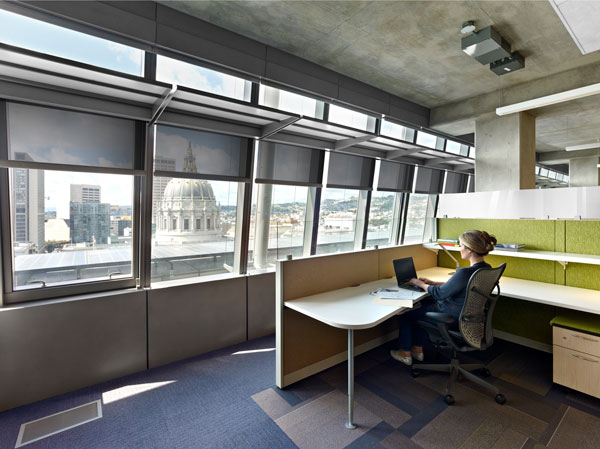San Francisco is blessed in a variety of ways. Aside from the big tech corporations of Silicon Valley pumping vast wealth into the veins of the California economy, the Bay Area is praised from both within and afar for things like its rooted demographic diversity, stability of employment opportunities, and a dining scene that is of such an esteemed caliber that it is often joked that Sunday brunch is its own economic sector. But some of the city’s most important touchstones are naturally endowed. Though its looming fog is the subject of popular derision, San Francisco enjoys a sunshine rate that’s reported to rest above the US average for nine months out of the year. It’s a fact that, though perhaps not well known, has been of critical use to certain players in the architectural world. The San Francisco Public Utilities Commission (PUC) headquarters is one recent example of a building designed to make sunlight its foremost survival need.

The San Francisco Public Utilities Commission (PUC) glass facade shines.
The building that houses the San Francisco PUC is a towering structure, topping at 13 stories tall and housing more than 900 employees. One might reason that to support the daily functions of an office of such stature, a great consumption of energy would be in order, but that would be a mistake. The American Institute of Architects recognized the San Francisco PUC building as one among the top 10 sustainable buildings in 2013. And, always ahead of the curve, window shading solutions provider MechoSystems’ pioneering technologies and innovations aided this esteemed distinction. By employing a careful set of energy-saving techniques and useful eco-conscious installations, the PUC headquarters consumes 32% less energy than similarly sized edifices, and 45% less than the standard model of all buildings belonging to the Class A (the PUC’s) category.
From dawn until dusk, the San Francisco PUC Headquarters building bathes in sunrays, as the large structure is comprised of glass from the ground up—allowing for maximal sunlight harvesting. While light shelves were installed to optimize collecting of natural daylight, shading devices were also abundantly deployed throughout the building’s interior to control intrusions like pestering glares and heat gains. To perfect the quality of lighting levels, different areas of the utility building were given careful consideration to determine which sort of lighting units would work with respect to each area. While dimmable LED fixtures were harnessed throughout the building, the brightness needed to amply light the workspace is dramatically insignificant due to the building’s sleek glass constitution where daylight travels freely.
From a technological standpoint, one of the most impressive features bestowed by MechoSystems was the company’s computerized automation shading system, SolarTrac. According to Guido Murnig, senior vice president at MechoSystems, the device was programmed “to insure the control of daylight on all elevations, adjusting to the altitude and azimuth of the sun while identifying the profile and incident angles of the sun on each elevation throughout the solar day and the entire solar year.” Essentially, the SolarTrac shading system adapts automatically to the natural ongoing changes affected by the sun, tweaking itself to fit the present terms of solar exposure.

Automated shades by MechoSystems allow PUC employees to enjoy the sun’s rays when it’s comfortable, aiding productivity and happiness in the workplace.
“We have to remember that the sun is dynamic and the exposure at different elevations and changing times of the day create continually evolving scenarios and solar encounters in the ever changing micro-climate,” Murnig says. By having the shades adjust in real time, daylight utilization, and thus human comfort and energy savings, are lifted to their optimum.
The San Francisco Public Utilities Commission building is an exemplary piece of architecture in more ways than one. Its commanding size, its beaming glass profile, and the highly advanced green technologies it comes equipped with, to name a few of the PUC’s striking qualities. But perhaps the most outstanding of all is the sheer feasibility of the prospect of abrogating oneself of the requisite personal responsibility to enhance the conditions of the environment, instead placing them in the hands of a faultless digital mechanism. The future of green building is looking easier, and greener, than ever.

